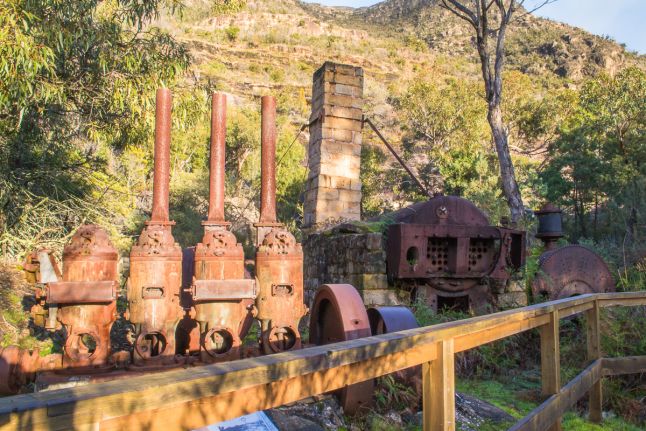A short, easy walking track takes you from the carpark off Mt Zero Road to the site of the site of the quarry. Detailed information signs are located alongside significant areas.
Heatherlie Quarry is a fantastic, educational place to visit. It's located 5 minutes from a
campground and less than 20 minutes from Halls Gap.
Campgrounds nearby
History of Heatherlie Quarry
Information signs at Heatherlie Quarry provide the following timeline of operations
- 1864 Two acre lease taken out by F. Watkins on future quarry site
- 1870s Stawell used sandstone in many public buildings
- 1880 Sandstone chosen for major works on Victoria's Parliament House
- 1882 Railway line opened from quarry to Stawell
- 1887 Township of Heatherlie surveyed
- 1890 Start of Great Depression. Men laid off as stone orders cease
- 1890s Picnic train trips from Stawell and Ararat become a regular event
- 1899 Quarry reopens with orders for major works on Melbourne buildings
- 1941 Railway line to Stawell closes. Quarry remains in operation until mid-1980s.
The Victorian Heritage Database provides the following information regarding Heatherlie Quarry
Heatherlie quarry is of historical, scientific (technical) and social significance at the State level. The quarry
provided the first really durable freestone (sandstone) discovered in Victoria and its development exemplifies the
technical, political and social problems associated with isolated industrial locations in the State.
It remains today
as the most complete illustration of quarrying methods for cut stone. Its north end has a sheer raking face and
examples of partly extracted blocks which retain evidence of the traditional wedge and feather technique.
Associated buildings, structures, approach and on-site railway workings plus machinery relics, provide insights
into the infractructure essential to any major quarrying operation.
The quarry is also of historical significance for its involvement, from 1882 onwards, with the supply of stone for
Parliament House Melbourne. The selection of the stone for Parliament House was the basis of protracted
contorversy regarding the relative quality and durability of Victorian compared with imported stone.
Other notable
uses of the stone include buildings at Stawell, such as the Court House of 1878-9, which was the government's
first experiment in using the stone and the town hall designed by John D'alton, and built in 1872-3, using the
freestone only for the dressings.
The cottages on the site are an excellent representation of the use of the stone in a vernacular fashion and must
be regarded as part of the site.
The survival of substantial pieces of machinery contributes to the significance of the site. The railway line from
Stawell is significant as a Government built branch-line to a privately operated quarry and retains remnants of
unique timber bridge structures.




